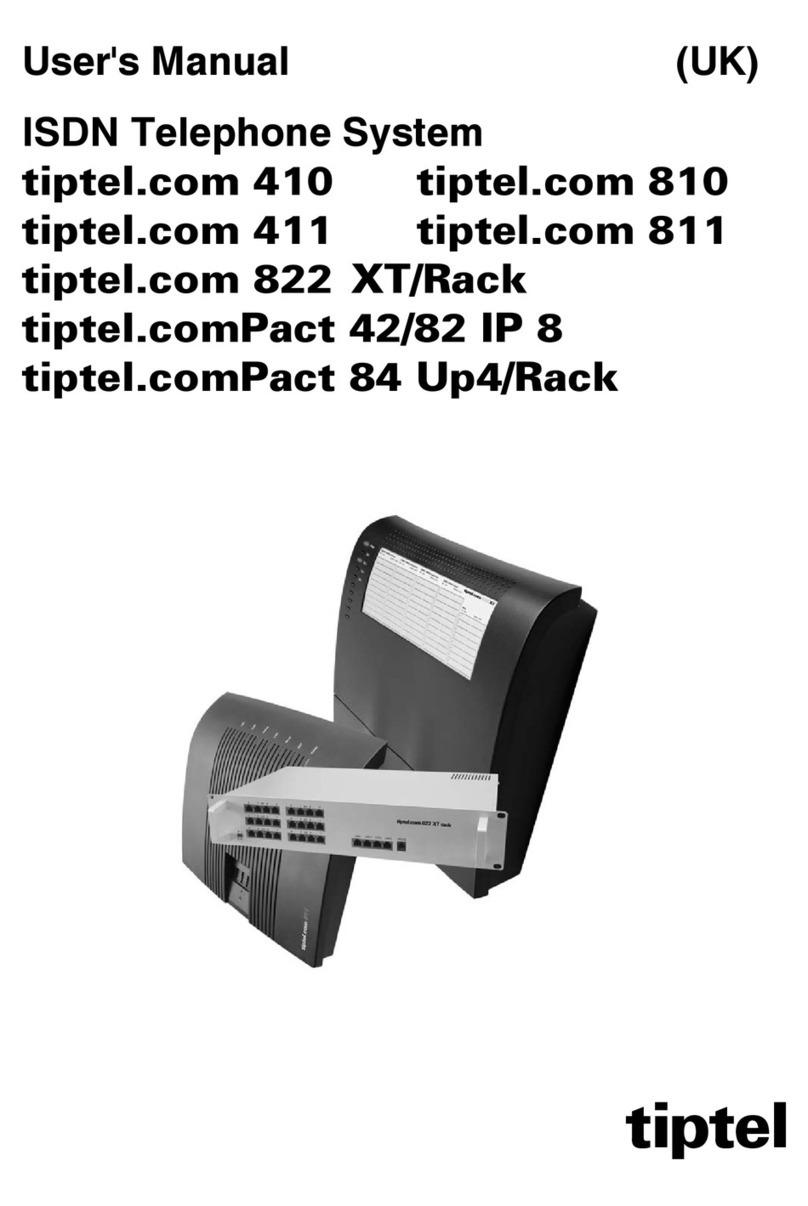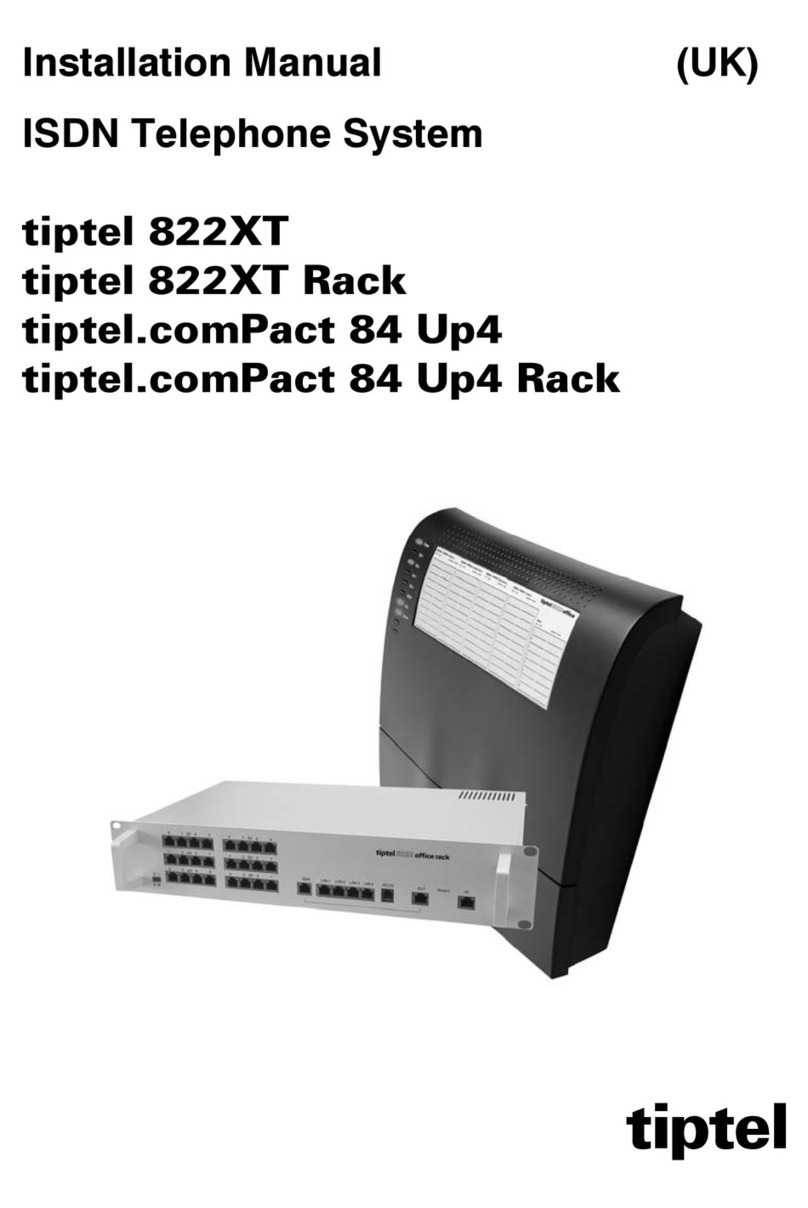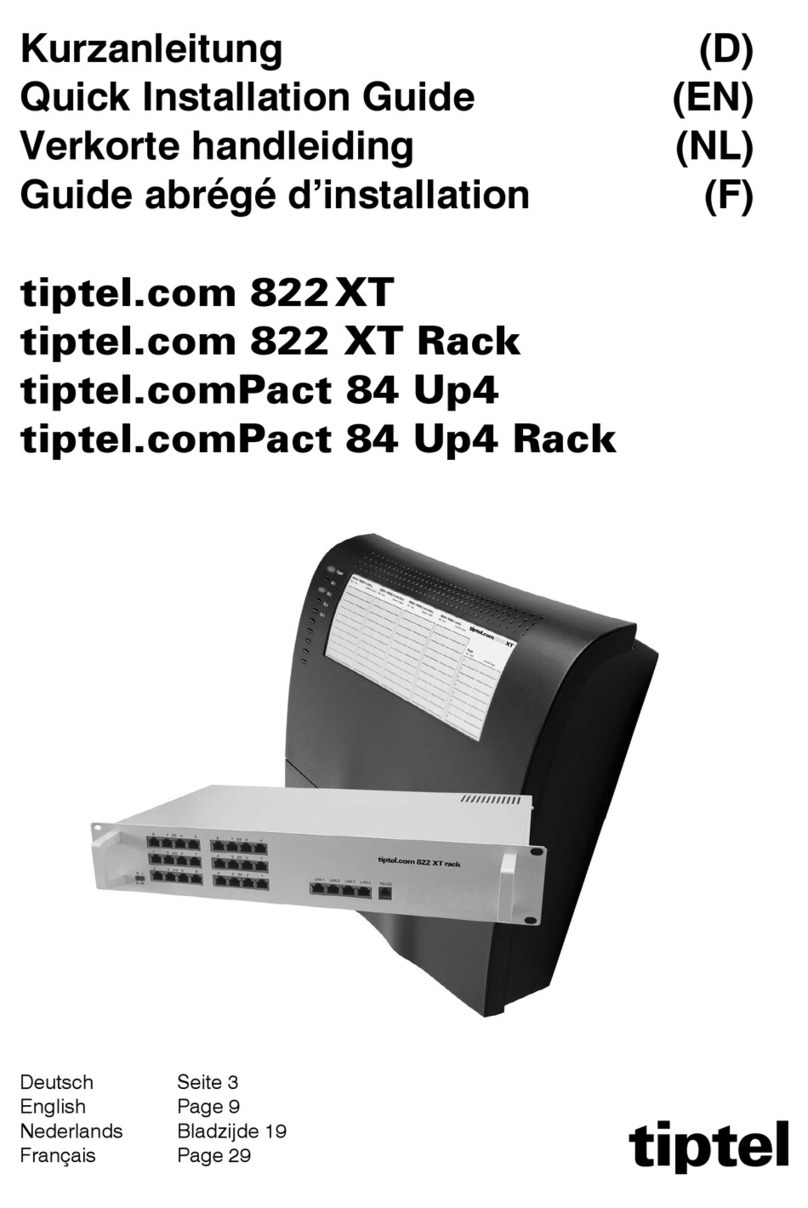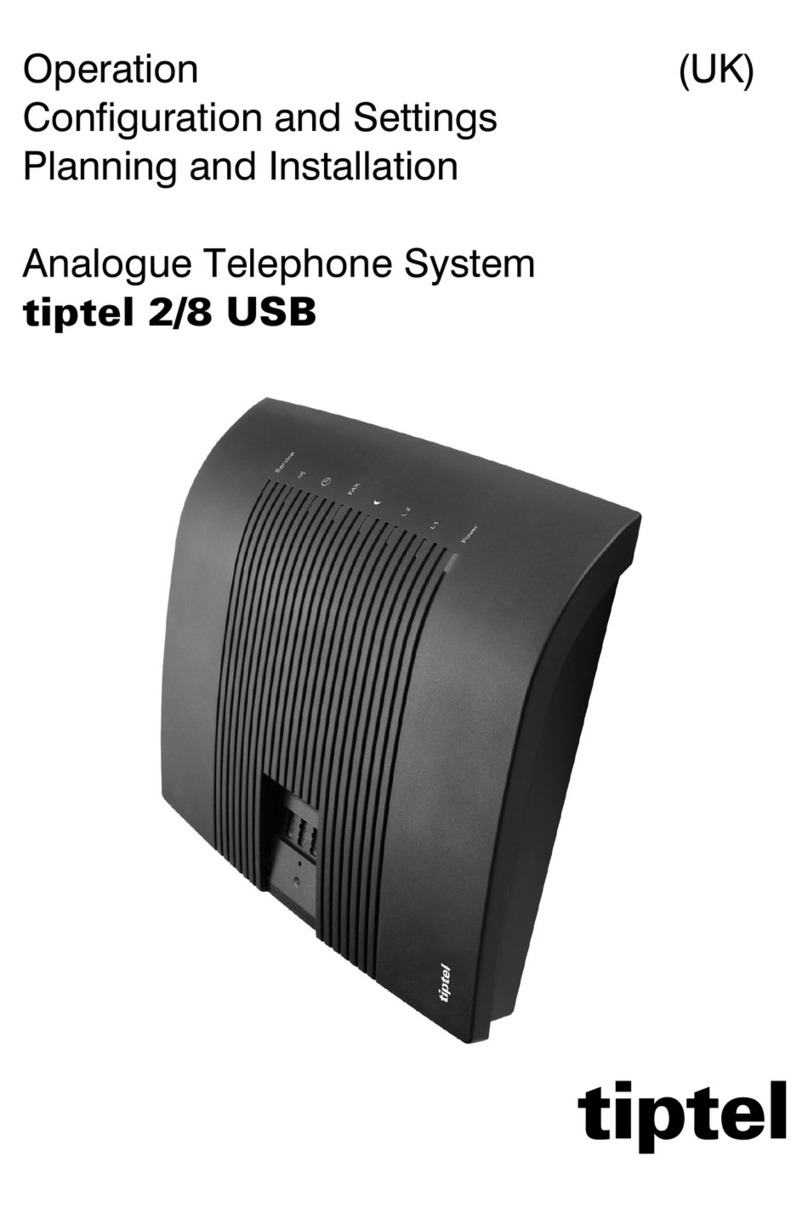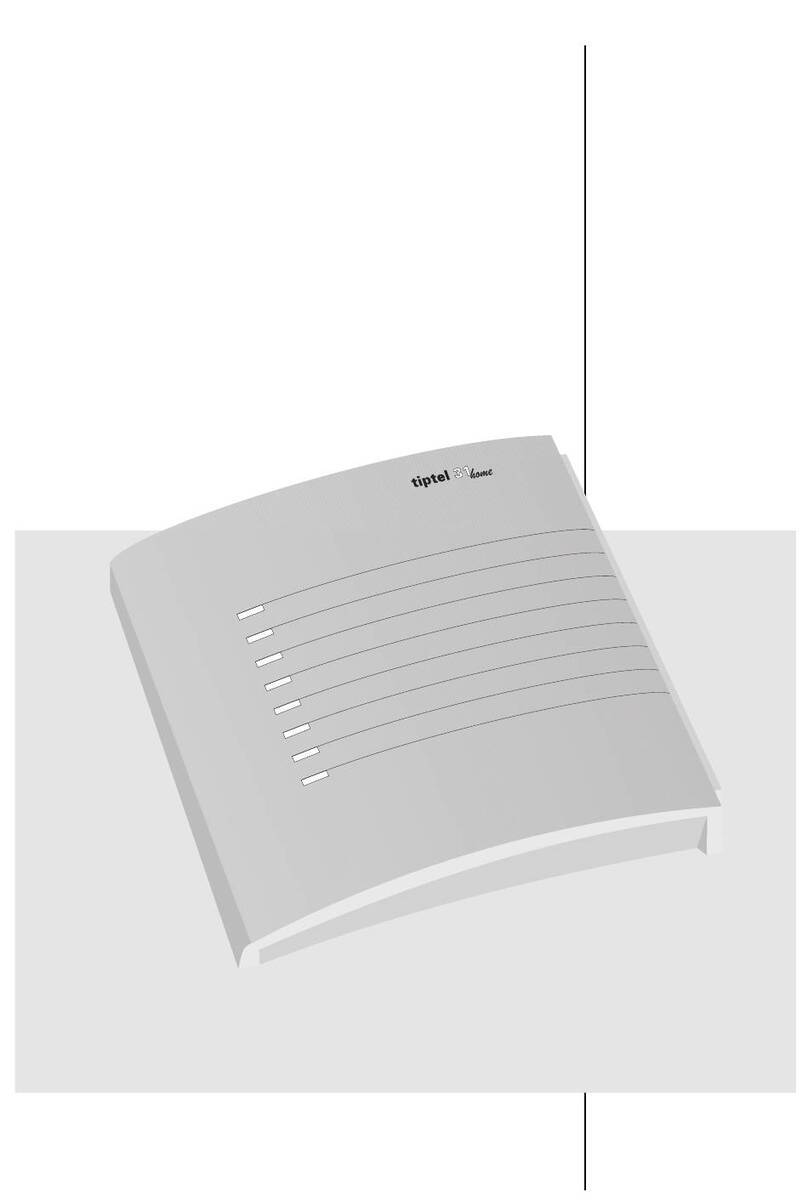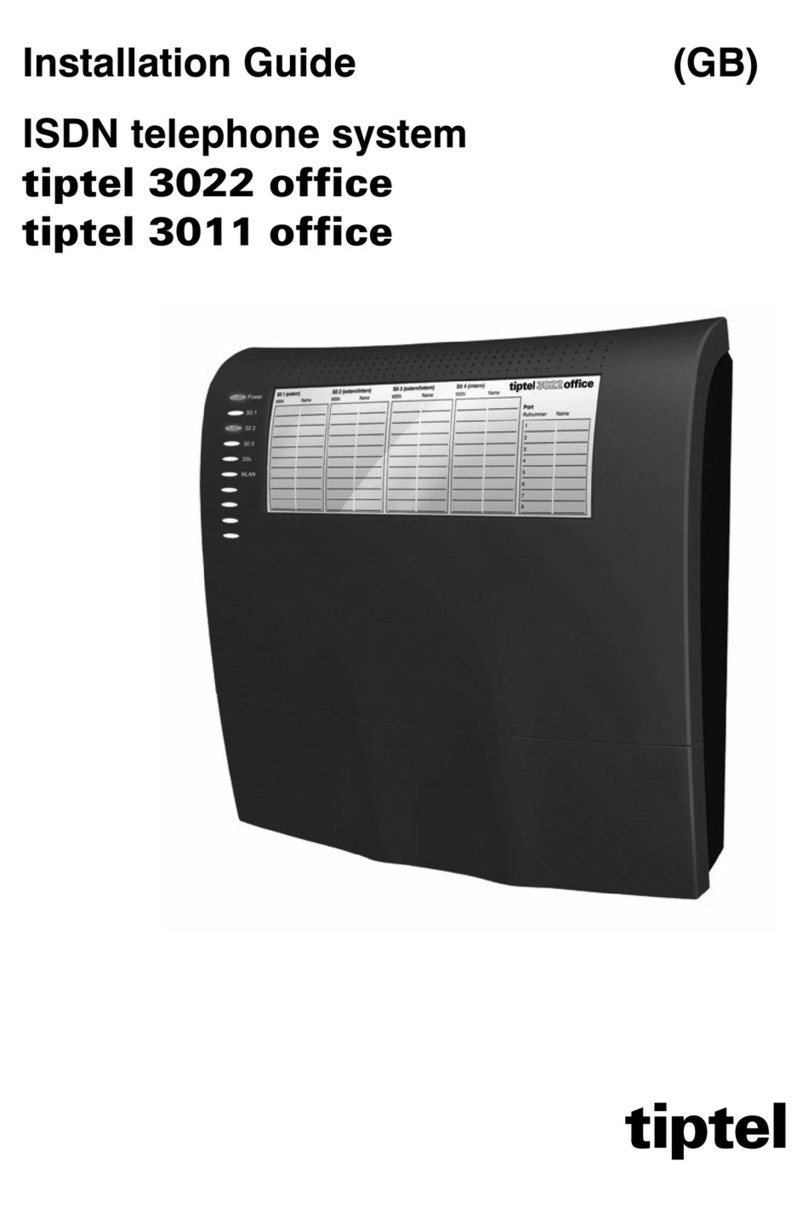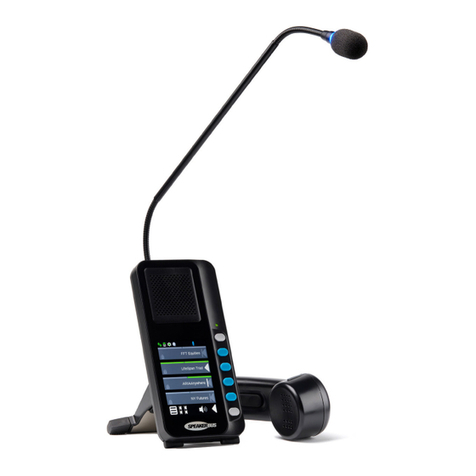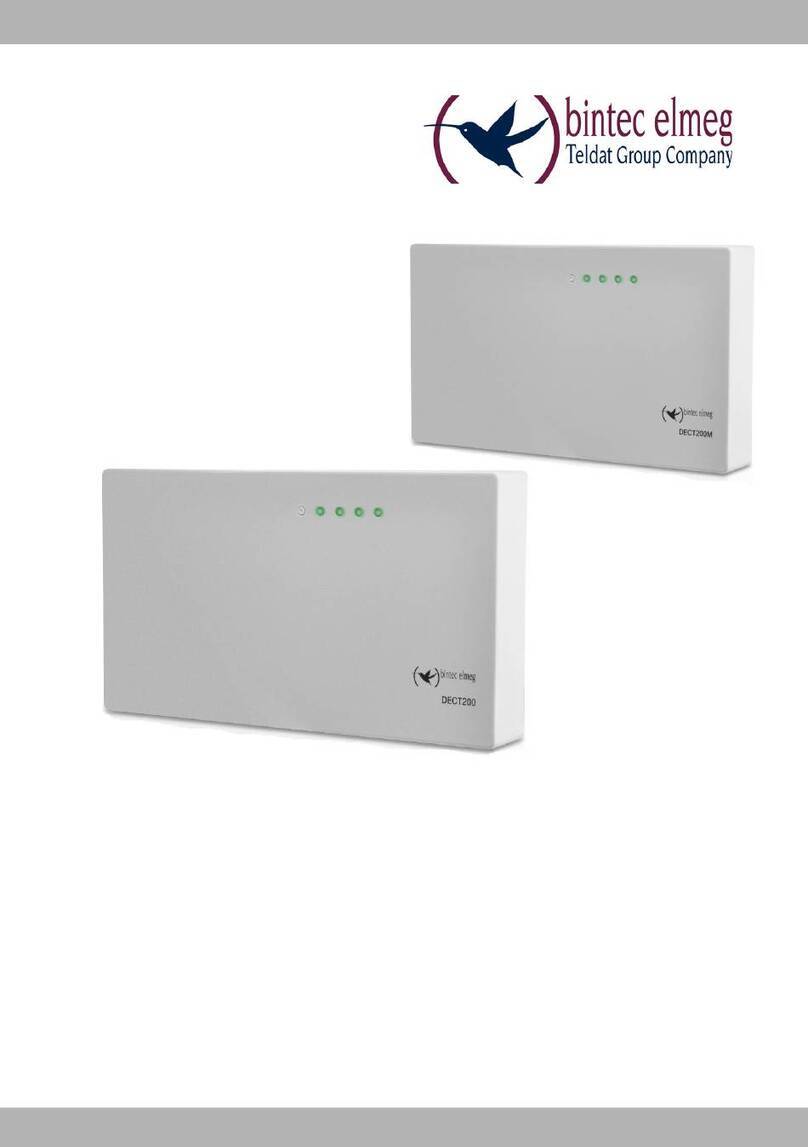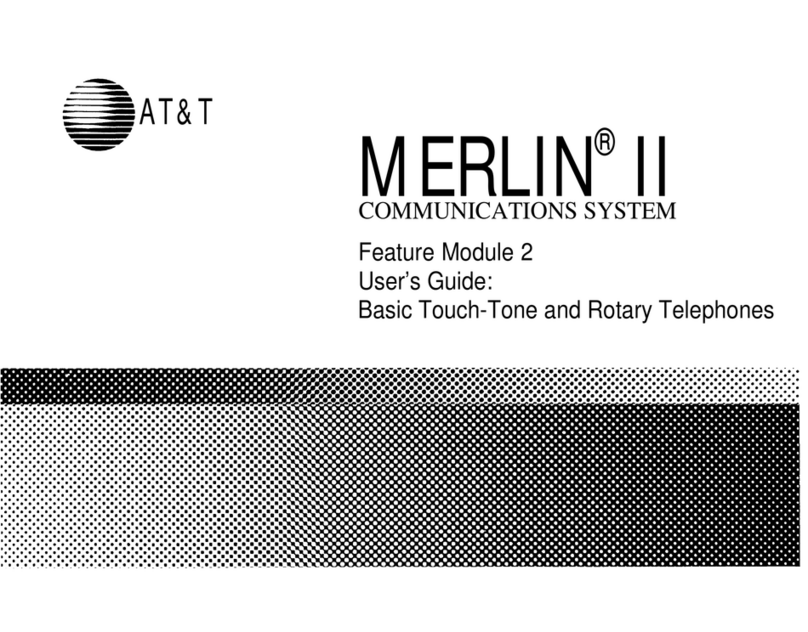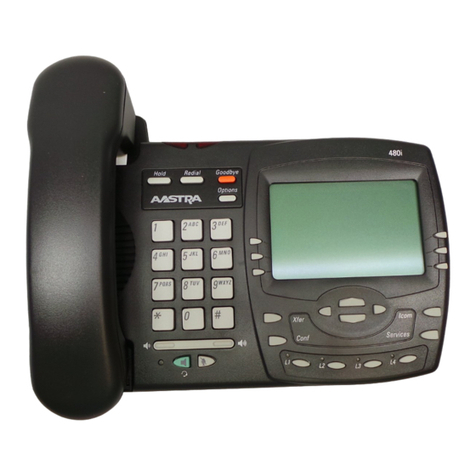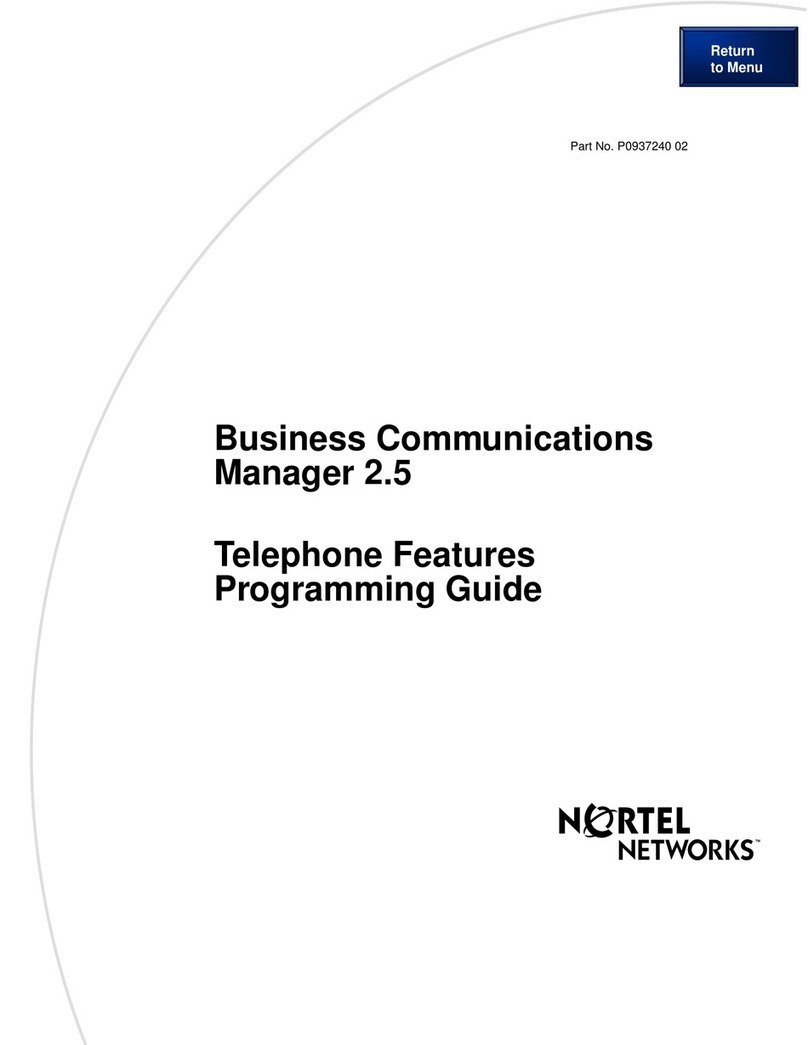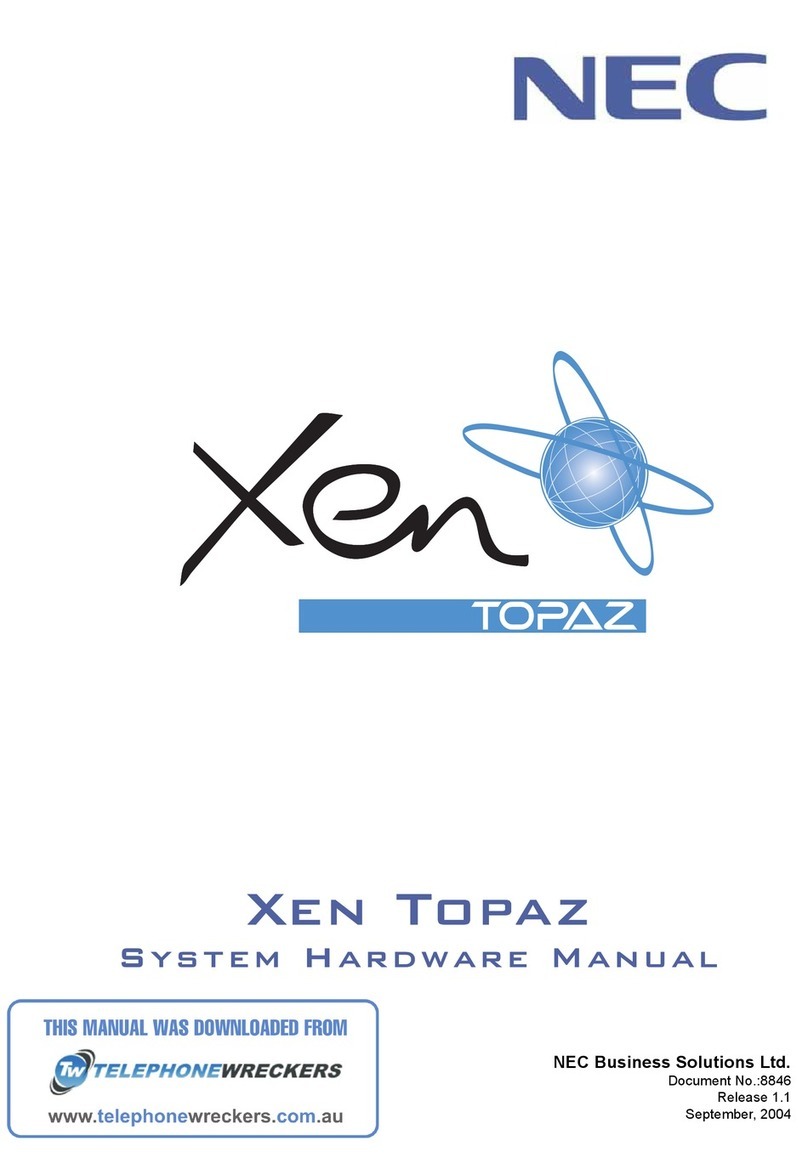TIPTEL 410 User manual

User's Manual (UK)
ISDN Telephone System
tiptel.com 410 tiptel.com 810
tiptel.com 411 tiptel.com 811
tiptel.com 822 XT/Rack
tiptel.comPact 42/82 IP 8
tiptel.comPact 84 Up4/Rack
tiptel

Table ofContents
3
Table of Contents
Table ofC ontents............................................................................................3
Notes ...............................................................................................................5
Directions foroperating the telephone system ...........................................................5
First calls .........................................................................................................6
Internalcall.............................................................................................................6
Externalcall............................................................................................................6
Inquiry call..............................................................................................................7
Inquiry callw ith calltransfer...................................................................................7
Extension features ..........................................................................................8
C allforw arding .......................................................................................................8
C onfiguration ..................................................................................................10
Analogue extension.....................................................................................................10
C allw aiting signalallow ed.....................................................................................10
Callnum beridentification ......................................................................................10
Functions.........................................................................................................11
W hen setting up the connection .................................................................................11
Selectoutgoing internalnum ber...........................................................................11
Pick-up....................................................................................................................11
Follow m e...............................................................................................................11
Speed dial..............................................................................................................12
Com pletion ofCallto Busy Subscriber(CCBS)....................................................12
Com pletion ofC allon N o Reply (CCNR)...............................................................13
During the call.............................................................................................................14
CallW aiting (C W )...................................................................................................14
M alicious CallIdentification (M C ID).......................................................................14
Hold ........................................................................................................................15
Conference.............................................................................................................15
Term inalPortability (TP).........................................................................................15
Inquiry /sw itching betw een lines...........................................................................16
ExplicitC allTransfer...............................................................................................17
O perating the answ ering machine .................................................................18
Rem ote access............................................................................................................18
Rem ote access functions............................................................................................19
Playback incom ing m essage function...................................................................19
Sw itching functions................................................................................................19
Changing outgoing m essages...............................................................................20
M essage transferfunction......................................................................................20
Sw itch offdevice function ......................................................................................20
Rem ote activation ofansw ering m ode ......................................................................21

4
Remote dialling-in ...........................................................................................21
Subscriber configuration via PC ....................................................................22
Subscriber .......................................................................................................24
Settings...................................................................................................................24
C allforw arding .......................................................................................................25
Charge account......................................................................................................26
Answ ering m achine.....................................................................................................26
ICM ..............................................................................................................................26
G eneral command summary ..........................................................................27
Function codes,only for analogue terminals ................................................29
During the call........................................................................................................29
Index................................................................................................................30

Notes
5
Notes
W e reserve the rightto m ake changes to this User's M anualorthe hardw are
described atany tim e and w ithoutpriornotice.The currentversion ofthe User's
M anualis also available as a pdffile on the Internetatw w w .tiptel.com .The texts and
illustrations ofthis user's m anualhave been com piled w ith the utm ostcare.H owever,
errors cannotbe ruled outcom pletely.The publishercan notbe held liable forany
incorrectinform ation orconsequences arising as a result.
Im portant:This m anualreflects the telephone system ,release 7.xx.Ifnecessary,
perform an update.
© 2010 Tiptel.com G m bH Business Solutions Ratingen.Allrights reserved.
Directions foroperating the telephone system
Before yourm ake yourfirstcall,you should m ake yourselffam iliarw ith the sym bols
used in this U ser's M anual.
In the User's M anual,the following sym bols are used forprogram m ing the system or
activating and deactivating features:
Pick up receiver
!......"# Enter code digits and key sequences
$..##% Enter special keys
&# R key: Flash function
## Hang up receiver
Note: O nly tiptel.com 411,811,822XT/Rack,tiptel.com Pact42/82 IP 8 and
tiptel.com Pact84 U p4/Rack supportISDN -and TIPTEL system -telephones.

Firstcalls
6
First calls
U pon delivery,the autom atic exchange connection is disabled w ithin the telephone
system .Dialthe line prefix "0"forCO line access.
Ifthe “autom atic exchange connection” feature has been activated,you can dial
“$$”#foran internalline,orw aitfor10 seconds afterpicking up the receiveruntil
you hearthe internaldialling tone.You can then dialdesired extension num ber.
After10 seconds,the telephone system autom atically sw itches to the internal
dialling tone.
Internal call
Analogue telephone 50:
Pick up receiver.
Y
ou hear the internal dialling tone.
'! Dial internal subscriber num ber.
Y
ou hear the ringing tone or the busy tone.
Analogue telephone 51:
Pick up receiver.
Y
ou are connected with the internal
subscriber.Place your call.
Hang up both receivers. Term ination of call.
External call
Analogue telephone 50:
Pick up receiver.
Y
ou hear the internal dialling tone.
(Dial line prefix.
Y
ou hear the external dialling tone.
(!)*+ Dial the phone num ber of the external
subscriber.
Y
ou hear the ringing tone or the busy tone.
External subscriber:
Pick up receiver.
Y
ou are connected with the external
subscriber.Place your call.
Hang up receiver. Term ination of call.

Firstcalls
7
Inquirycall
Analogue telephone 50:
Pick up receiver.
Y
ou hear the internal dialling tone.
'! Dial phone num ber. Signal to telephone 51.
Analogue telephone 51:
Pick up receiver.
Place your call with telephone 51.
&#Initiate inquiry call.
Y
ou hear the internal dialling tone.
')# Dial phone num ber. Signal to telephone 52.
Analogue telephone 52:
Pick up receiver.
Place your call with telephone 52.
&)# Term inate inquiry. Place your call with telephone 51.
Hang up all receivers. Term ination of call.
Inquirycall with call transfer
Analogue telephone 50:
Pick up receiver.
Y
ou hear the internal dialling tone.
'! Dial phone num ber. Signal to telephone 51.
Analogue telephone 51:
Pick up receiver.
Place your call with telephone 51.
&#Initiate inquiry call.
Y
ou hear the internal dialling tone.
')# Dial phone num ber. Signal to telephone 52.
Analogue telephone 50:
Hang up receiver.
Analogue telephone 52:
Pick up receiver.
Active call between telephones 51 and 52.
Hang up all receivers. Term ination of call.

Extension features
8
Extension features
The following listdescribes the features provided forthe differentextensions.
Note:M any ofthe features are displayed on ISDN term inals and can be enabled
directly via speed dialling keys.Because ofthe huge diversity ofterm inals
available on the m arket,operating instructions cannotbe provided here.Please
consultthe U ser's M anuals ofthe appropriate term inals.
Call forwarding
C allforw arding is executed w ithin the telephone system and can be configured
individually foreach extension.Itis possible to forw ard calls to internaland external
calling destinations.
There are three authorisation levels forenabling callforw arding:
!no callforw arding perm itted
!callforw arding perm itted only to internaldestinations
!callforw arding perm itted to internaland externaldestinations
The following exam ples assum e thatthe callforw arding is setup on one’s own
telephone in allcases.
C all Forw arding Unconditional (C FU)
Incom ing calls are im m ediately routed to the program m ed destination phone
num ber.Yourow n term inaldoes notdisplay a notification forthe call.This setting is
recom m ended forbusiness trips,holidays,etc.
C all Forw arding on B usy (C FB )
Incom ing calls are forw arded to anotherterm inalifyourow n extension is busy.
N ote:In orderforthe C FB feature to w ork properly,itis absolutely essentialto
disable the "callw aiting"feature atthe appropriate term inaldevice(s).
C all Forw arding No R eply (C FNR)
Incom ing calls are firstsignalled on yourown term inal.Ifthe callis notansw ered
during this tim e,itw illbe forw arded to the callforw arding destination.

Extension features
9
Ifcallforw arding is enabled,itis indicated on the term inalby a specialdialling
tone thatyou w illhearafterpicking up the receiver.O utgoing calls are possible
from the term inalw ithoutrestrictions.
To enable the differenttypes ofcallforw arding,the follow ing key sequences m ustbe
entered:
!C allForw arding U nconditional(C FU )off $)!$
!C allForw arding U nconditional(C FU )on
w ith destination phone num ber %)!% destination $
!C allForw arding N o Reply (C FN R)off $,!$
!C allForw arding N o Reply (C FN R)on
w ith destination phone num ber %,!% destination $
!C allForw arding on Busy (C FB)off $,-$
!C allForw arding on Busy (C FB)on w ith
destination phone num ber %,-% destination $
W hen program m ing an externaldestination num ber,the line prefix ((#as standard)
m ustalso be entered.
The inputis concluded by a positive acknow ledgem enttone oran errortone.
The callforw arding alw ays refers to the program m ed outgoing M SN .
ISDN telephones are program m ed via the keypad orvia individualm enus using
the appropriate ISDN services.Please consultthe User's M anualofyourISDN
term inals.

Configuration
10
Configuration
Analogue extension
Call waiting signal allowed
Atanalogue extensions,the callw aiting signalis enabled ordisabled w ith the
follow ing key sequences:
!Call waiting off $+*$#
!Call waiting on %+*$#
The entry is confirm ed by a positive confirm ation tone.
Note:IfISDN telephones are connected,this feature is m anaged by the term inal
itself.To program m e the calling line identification services atyourterm inals,
please consultthe User's M anuals foryourISDN telephone.
Call num beridentification
There are tw o types ofcalling line identification services:
!Calling Line Identification Presentation (C LIP)or
Calling Line Identification Rectification (CLIR):
Yourow n phone num beris transm itted /nottransm itted to the destination
subscriberforoutgoing calls.
!Connected Line Identification Presentation (CO LP)or
Connected Line Identification Restriction (CO LR):
W hen accepting an incom ing call,the destination telephone num beris
transm itted /nottransm itted to the callerw ho m ade this call.
Atanalogue extensions,this feature can be enabled ordisabled w ith the follow ing
key sequences:
!Phonenumbertransmission off $*($
!Phonenumbertransmission on %*($
The entry is confirm ed by a positive confirm ation tone.
IfISDN telephones are connected,this feature is m anaged by the term inalitself.
To program m e the calling line identification services atyourterm inals,please
consultthe User's M anuals foryourISDN telephone.

Functions
11
Functions
W hen setting up the connection
Select outgoing internal num ber
Analogue telephone for subscribers
40,41:
Pick up receiver.
Y
ou hear the internal dialling tone.
%#(#M SN##$Dial key sequence,M SN represents the
desired outgoing internal num ber (for
exam ple 41).
Y
ou hear a positive confirm ation tone.
Hang up receiver. End of setting.
ISDN telephones are program m e via individualm enus.Please consultthe User's
M anualofyourISDN term inals.
Pick-up
W hen anothertelephone rings,you can take overthe callw ith yourown telephone
(pick-up). Pick-up is available forinternaland externalcalls.
In orderto pick up a call,the follow ing key sequence has to be entered:
!Pick-up # %'#
Requirem ent:The pick-up feature m ustbe enabled forthe subscriberw ho is to pick
up the call.
Follow m e
This function allow s you to transferthe callforw arding ofyourinternalnum berto the
phone num berofyourcurrentlocation.
Press the following buttons to apply callforw arding to the otherextension:
!Follow m e %))% (ow n phone num ber)#$#
Requirem ent:Ifcalls are to be picked-up by a subscriber,itis firstnecessary to
activate the follow-m e option forthis subscriber.

Functions
12
Speed dial
A speed dialling listis available forfrequently used telephone num bers.Up to 100
phone num bers ofup to 24 digits each can be stored.These phone num bers can be
dialled by every subscriber.
Speed dialling is carried outvia the key sequence %#-#(( -%-#"".The keys ((# -
#"" representthe speed dialling index.
Itis possible to dialadditionaldigits afterthe speed dialling num ber.To do this,
sim ply enterthe requested digits afterthe speed dialling num ber.
Ifthe autom atic exchange connection feature has been activated and the handset
is lifted,itis possible to sw itch to the internaldialling tone by entering the $$#key
sequence.N ext,the requested speed dialling num bercan be entered.
After10 seconds,the telephone system autom atically sw itches to the internal
dialling tone.
Please consultthe "speed dialling"chapterin the installation guide forfurther
inform ation.
Com pletion of Call to Busy Subscriber(CCBS)
Ifthe destination subscriber’s line is busy,the connection w illbe setup autom atically
as soon as the externalorinternaldestination subscriberterm inates his call.The
CC NR feature m ustbe enabled by the caller.W hen the destination subscriberhangs
up,the callerreceives a callsignal.U pon picking up the receiver,the connection to
the destination subscriberis established w ithoutany furtherdialling necessary.The
autom atic connection is then com plete.
Initiation ofa CCBS depends on the kind ofterm inalused:
!If a DTMF dialling terminal isused,theautomaticcall-backcan beenabled
byentering thefollowing keysequence(s):
oenabling ofCCBS:&#%*-$###
odisabling ofC CBS: $*-$###
Ifan ISDN term inalis used and ifthe CC BS feature is supported,the autom atic
call-back feature can be enabled using a speed dialling key.
Forfurtherinform ation,please consultthe User's M anualofthe ISDN term inal.
Ifan analogue term inalis used,you heara positive confirm ation tone as soon as the
CC NR requesthas been registered w ithin the telephone system .In the eventofan
error,you w illhearan errortone.Ifthe feature is notsupported,you heara negative
confirm ation tone.

Functions
13
CC NR requests are deleted from the telephone system after60 m in.This period of
tim e depends on the public exchange office ifexternalsubscribers are to be called.
Requirem ents:In case ofexternalcall-backs the CC BS feature m ustbe supported
and enabled by yourow n netw ork provideras w ellas the netw ork providerofthe
called subscriber.
Com pletion of Call on No Reply(CCNR)
Ifthe destination subscriberdoes notansw era call,the connection w illbe
established autom atically as soon as the destination subscriberhas m ade another
call.The CC NR feature m ustbe enabled by the caller.W hen the destination
subscriberhangs up,the callerreceives a callsignal.Upon picking up the receiver,
the connection to the destination subscriberis established w ithoutany furtherdialling
necessary.The autom atic connection is then com plete.
Initiation ofa CCN R depends on the kind ofterm inalused:
!Ifa DTM F dialling term inalis used,the autom atic call-back can be enabled
by entering the follow ing key sequence(s):
oenabling ofCCN R:&#%!($###
odisabling ofC CN R: $!($###
Ifan ISDN term inalis used and ifthe CC NR feature is supported,the autom atic
call-back can be enabled using a speed dialling key.Forfurtherinform ation,
please consultthe User's M anualofthe ISDN term inal.
Ifan analogue term inalis used,you heara positive confirm ation tone as soon as the
CC NR requesthas been registered w ithin the telephone system .In the eventofan
error,you w illhearan errortone.Ifthe feature is notsupported,you heara negative
confirm ation tone.
CC NR requests are deleted from the telephone system after60 m in.This period of
tim e depends on the public exchange office ifexternalsubscribers are to be called.
Requirem ents:In case ofexternalcallbacks the CC NR feature m ustbe supported
and enabled by the caller’s netw ork providerand the netw ork providerofthe
subscribercalled.

Functions
14
During the call
Call W aiting (CW )
Ifa destination subscriber’s line is busy,this subscriberhears a callw aiting signalas
soon as a second callcom es in.
The destination subscribercan rejectthe w aiting call.In this case,the calling
subscriberhears the busy tone.The otherpossibility is thatthe destination
subscriberaccepts the w aiting call,and the currentcallis placed on hold.
Ifanalogue term inals are used,w aiting calls are handled as follows:
!Acceptw aiting call &#)#
!Acceptcallw aiting and term inate currentconversation *
!Rejectw aiting call +
!Forw ard caller(w ithoutaccepting) &#+#
Then entertargetphone num ber.
IfISDN term inals are used,w aiting calls are accepted orrejected via
corresponding m enus.Please consultthe User's M anualforyourISDN telephone.
M alicious Call Identification (M CID)
The M C ID feature is used to identify m alicious callers.The caller’s num beris stored
in the operator’s netw ork and notified on request.C alltracing is possible during an
active connection and w ithin 20 sec thereafter.Itis necessary to apply forthe
enabling ofthis feature w ith the netw ork operator.Charges are levied forthe use of
this feature.
IfISDN telephones are connected,this feature is m anaged by the term inalitself.
Forprogram m ing this feature atan ISDN term inal,please consultthe U ser's
M anualforyourISDN telephone.
Ifanalogue term inals are used,the feature can be enabled via the follow ing key
sequences:
!Trace subscriber &#$#(#&#
!or &#$#(#hang up
Requirem ent:The feature M C ID m usthave been enabled by the netw ork operator.

Functions
15
Hold
There are tw o w ays to place incom ing externalcalls on hold:eitherexternally w ithin
the exchange orinternally w ithin yourtelephone system .The setting in w hich w ay
calls are puton hold w as perform ed by the installerofyourtelephone system .
O ne ofthe differences is thatifa callhas been placed on hold w ithin the exchange,
the externalcallerhears the m usic-on-hold selected by the netw ork provider.During
the hold w ithin yourtelephone system ,yourown m usic-on-hold is heard.
Conference
W hen a subscriberhas a callon hold and an active call,he/she can setup a three-
w ay conference.In this case,the three subscribers w illbe interconnected w ithin the
telephone system .A m axim um offourinternalthree-w ay conferences is possible.If
the subscriberinitiating the conference hangs up,allconnections w illbe term inated.
Ifone ofthe othersubscribers hangs up,the connection betw een the tw o other
subscribers rem ains active.
Ifanalogue term inals are used,a three-party conference can be initiated via the
follow ing key sequence:
!Initiate conference &#*
IfISDN telephones are connected,this feature can be enabled by the term inal
itselfvia speed dialling keys.Forenabling this feature,please consultthe User's
M anualforyourISDN telephone.
In case oftw o externalsubscribers,the conference can be initiated w ithin the
exchange,provided thatboth have been sw itched via the sam e S0 connection.It
should be noted in this regard thatadditionalcharges can be levied by the netw ork
providerfora three-party conference w ithin the exchange.
Term inal Portability (TP)
Ifyou w ish to continue an active callfrom anotherpartofthe building,you can park
the callw ithin the telephone system and rem ove itfrom anotherextension.After
initiating parking,you can disengage parking w ithin three m inutes atanother
extension and thencontinue the callw ith the person you are calling.
To program m e this feature atan ISDN term inal,please consultthe User's M anual
foryourISDN telephone.
Ifanalogue term inals are used,this feature can be initiated as follow s:
!parking a call: &%.(% tw o-digitparking num ber$#

Functions
16
!Rem ove a callfrom parking: %.!% tw o-digitparking
num ber$
Inquiry/switching between lines
This feature gives you the option ofputting an internalorexternalcallon hold in
orderto place an inquiry call.D uring the tim e ofinquiry,the subscriberhears m usic-
on-hold.Afterterm ination ofyourinquiry call,you can resum e the firstcall.
Initiation ofan inquiry depends on the kind ofterm inalused:
!w ith ISD N term inals via the &-key orvia a m enu provided and use ofthe
speed dialling keys
!w ith DTM F dialling term inals by pressing the &-key
Analogue telephone 50:
Pick up receiver.
Y
ou hear the internal dialling tone.
'! Dial phone num ber. Signal to telephone 51.
Analogue telephone 51:
Pick up receiver.
Place your call with telephone 51.
&# Initiate inquiry call.
Y
ou hear the internal dialling tone.
')# Dial phone num ber. Signal to telephone 52.
Analogue telephone 52:
Pick up receiver.
Place your call with telephone 52.
&#)# Two-line conversation with hold. Place your call with telephone 51.
&#!# Term inate call with telephone 51. Place your call with telephone 52.
Hang up all receivers. Term ination of call.

Functions
17
Explicit Call Transfer
This feature gives you the options ofconnecting tw o calls.Forexam ple,ifyou have
an active calland a callon hold,you can interconnectboth subscribers.
Analogue telephone 50:
Pick up receiver.
Y
ou hear the internal dialling tone.
'! Dial phone num ber. Signal to telephone 51.
Analogue telephone 51:
Pick up receiver.
Place your call with telephone 51.
&# Initiate inquiry call.
Y
ou hear the internal dialling tone.
')# Dial phone num ber. Signal to telephone 52.
Analogue telephone 52:
Pick up receiver or – for call transfer
without prior notice – proceed with the
next step.
Place your call with telephone 52.
Analogue telephone 50:
Hang up receiver.
Connection between telephones 51 and 52.

O perating the answ ering m achine
18
Operating the answering m achine
N ote: The function answ ering m achine is available only iftiptelVC M -m odule is
installed.
The installation and configuration ofansw ering m achines are described in the
installation m anual.The operating ofthe answering m achines can be done from a
localphone by the code "*( orby rem ote access from anyw here in the world
using the keypad on a Dual-tone M ultiple Frequency (DTM F)touchtone telephone.
You need a personalaccess code to access the phone rem otely.You can setyour
personalrem ote access code as described in "Settings".
Rem ote access
!Call your personal answering m achine.
Internally available under 930 from the
assigned subscriber.Otherwise,call the
subscriber using the extension/direct
dial num ber.
Y
ou hear the current announcem ent.
Enter the rem ote access code via the
t
elephone keypad.If you m ake a
m istake delete entry using the * key and
start again.
A voice m essage confirm s recognition of each
digit.
$To confirm the entry press the # button. If the correct code is detected your VCM
m odule 14 notifies you via a voice m essage.If
t
he code is incorrect,the device term inates the
connection.
Note: Ifyou have activated the Q RC function (referto “Installation M anualofyour
tipteltelephone system ”)forthe callnum berfrom w hich you are calling,your
personalansw ering m achine answ ers directly w ith the voice m essage.Then you
do nothave to enteryourrem ote access code.
Start the desired function by entering the
relevant digit (e.g.Num ber 2 to playback
all new incom ing m essage).
Each digit is confirm ed.
.Press digit 8 to end a function. The current function ends.
%$End rem ote access by pressing star and
hash in succession.

O perating the answ ering m achine
19
Rem ote access functions
Playback incom ing m essage function
*#To playback all messages
Press 3.
The playback starts with the oldest recording.
%*# To playback all messages
Press *3.
The playback starts with the newest recording.
)To playback new messages
Press 2.
Starts playback of recordings that have not yet
been heard beginning with the oldest m essage.
%)# To playback new messages
Press *2.
Starts playback of recordings that have not yet
been heard beginning with the newest m essage.
'Repeat
Press 5 during playback.
The last three seconds are repeated.
.To pause playback
Press 8.
Playback is paused.
'To continue playback
Press 5.
Playback is continued from where it was
paused.
+,Skip
Press 4 for back or 6 for forwards during
playback.
The m essage you are listening is skipped or
repeated.
)Repeat
Press 2 during playback.
Playback is paused and the caller’s num ber is
announced (requires call num ber transfer being
perm itted by the network provider).
-To delete the current message
Press 7 during playback.
The current incom ing m essage is deleted.
%-To delete all messages
Press * and 7 in succession.
All incom ing m essages are deleted.
Switching functions
%+To switch message transfer on/off
Press * and 4 in succession.
The current status "on"or "off"is announced.
Im portant note: The type of m essage forwarding
(e.g.SM S or call)m atches the m ost recent
setting in the web interface.
-
(..."
Change between messages
Dial num ber 7 and the desired m essage 0
… 9 in succession.
The selected outgoing m essage is played back
for checking.The next caller is greeted with this
m essage.

O perating the answ ering m achine
20
Changing outgoing m essages
"
!..."
Change the messages
Dial num ber 9 and the desired m essage 1
… 9 in succession.
Y
our personal answering m achine requests you
t
o speak.
"If you have called the M SN of an
answering m achine you can only
change your own m essages 8 and 9!
Record an outgoing m essage.
.For an outgoing m essage with incom ing
m essage option After recording the
outgoing m essage press 8.
The announcem ent is played back for checking.
At the end you hear one signal tone.
or
$For a announcem ent without incom ing
m essage option (announcem ent only):
After recording the announcem ent press # .
The announcem ent is played back for checking.
At the end you hear two signal tones.
M essage transferfunction
%"Change the destination call number for
message forwarding
Press buttons * and 9 in succession.
The current destination call num ber is
announced.A request to enter a new target call
num ber then follows.
Enter the new target call num ber. Each digit is confirm ed.
%To delete the target call num ber press the *
button.
The destination call num ber is deleted.
$To accept the target call num ber,press the
# button.
The new target call num ber is played back for
checking.
Switch off device function
%(Switching answering mode off
Press * and 0 in succession.
Y
our personal answering m achine is deactivated
and will not answer any m ore calls.

Rem ote dialling-in
21
Rem ote activation of answering m ode
!Call the call num ber of your personal
answering m achine (M SN).
After 50 seconds the device answers with a
beep.
Enter rem ote access code via the
t
elephone keypad and accept by
pressing the # button.
The announcem ent is played for checking.The
device can be operated rem otely (e.g.to
record a announcem ent).After term inating the
rem ote access your personal answering
m achine is ready and will answer calls.
Note: The rem ote activation option requires thatyou have previously entered a
rem ote access code in yourtelephone system forthe M SN called and thatyou
have sw itched on the “Rem ote activation” function (referto the “Installation
M anualofyourtelephone system ”).
Note: Ifyou callthe device from a callnum berstored as a “Q RC” (referto
“Installation M anualofyourtelephone system ”)in yourtelephone system and the
device is sw itched off,itansw ers im m ediately w ith the usualvoice m essage.By
entering %! you can now rem otely sw itch yourpersonalansw ering m achine on
atany tim e.You receive a voice confirm ation (“answering m ode on”).
Rem ote dialling-in
Itis possible to access yourtelephone system from a rem ote location.In this case,
you are eitheridentified by m eans ofthe outgoing phone num bersentorby entering
a PIN code.Itis also possible forthe telephone system s to carry outa call-back.
O nce connected to the telephone system ,you m ay use allconfiguration options,i.e.
itis possible to m odify callforw arding.N otonly aftera call-back butalso afterthe
directdialling-in,itis possible to selecta C O -line and to directly setup a connection
via the telephone system to otherexternalsubscribers (call-back,call-through).
This helps to reduce callcharges and itis possible,forexam ple,to hold a telephone
callon yourcom pany’s costcentre.This can be helpfulto distinguish private and
business calls fortax purpose.
Contactyoursystem adm inistrator/telephone system installerifthis function should
notbe activated.H e can,forexam ple,activate yourm obile phone num berorassign
a PIN .
Other manuals for 410
2
This manual suits for next models
6
Table of contents
Other TIPTEL Telephone System manuals
Popular Telephone System manuals by other brands
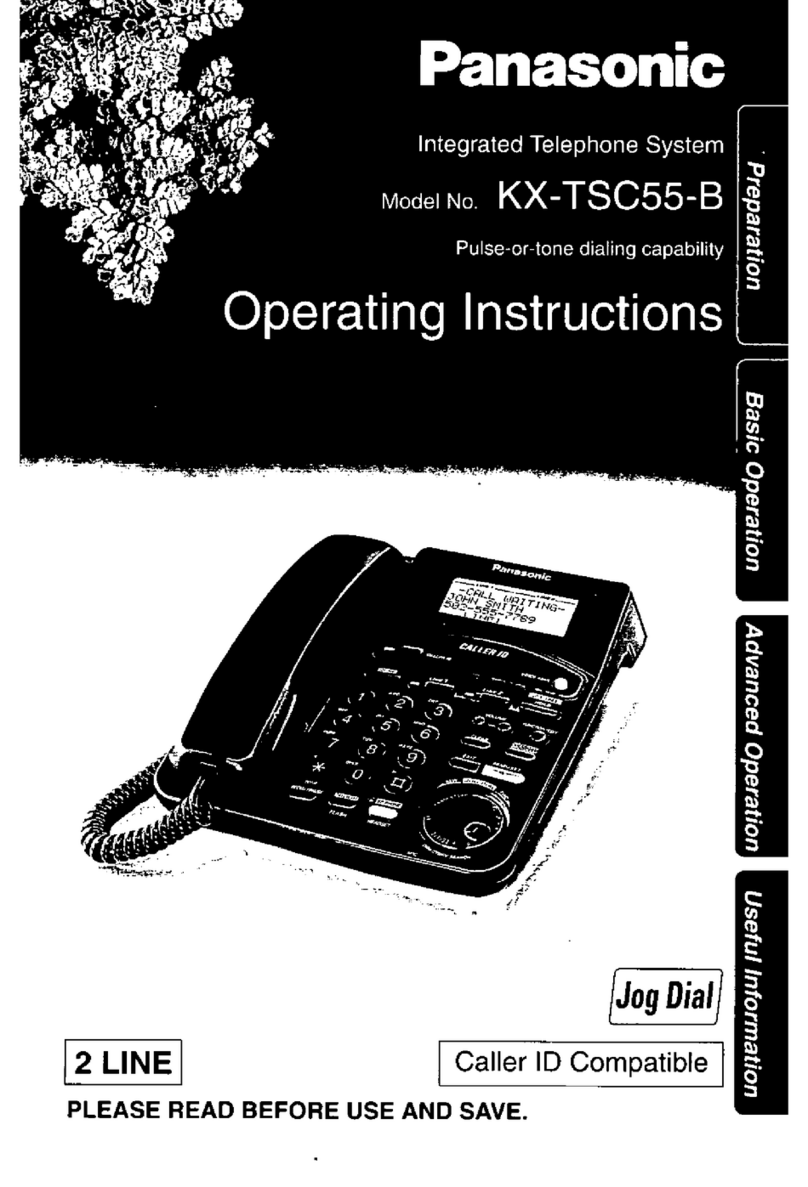
Panasonic
Panasonic KXTSC55B - PHONE/ANSWER MACHINE user guide

Panasonic
Panasonic EASA-PHONE KX-T30850 user guide

NEC
NEC XN120 Vision Getting started guide
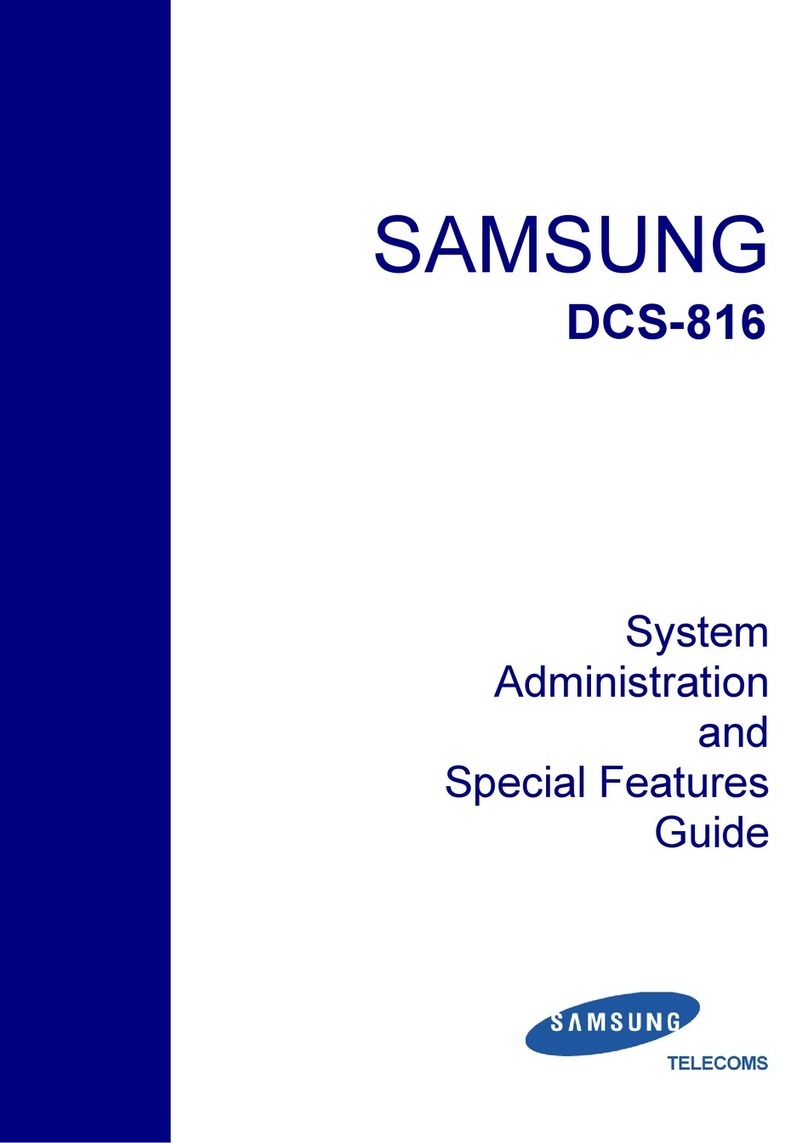
Samsung
Samsung DCS-816 System administration and special features guide
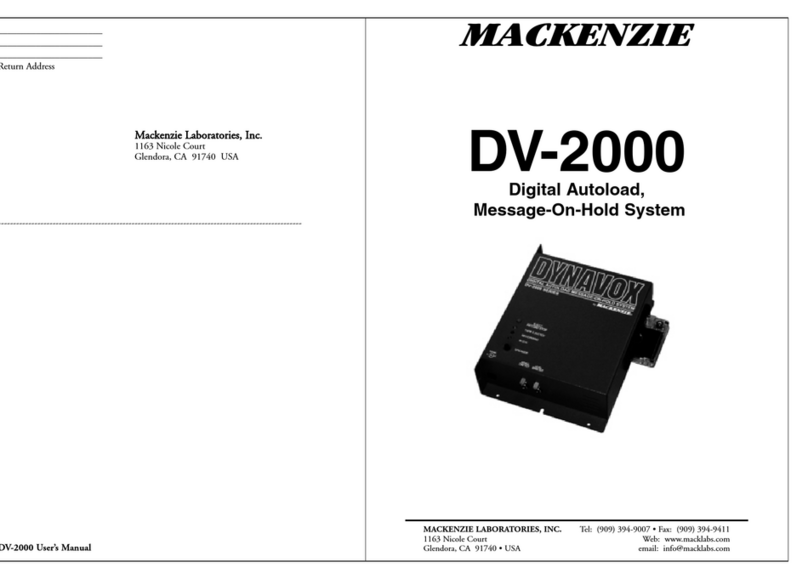
Mackenzie
Mackenzie DV-2000 user manual
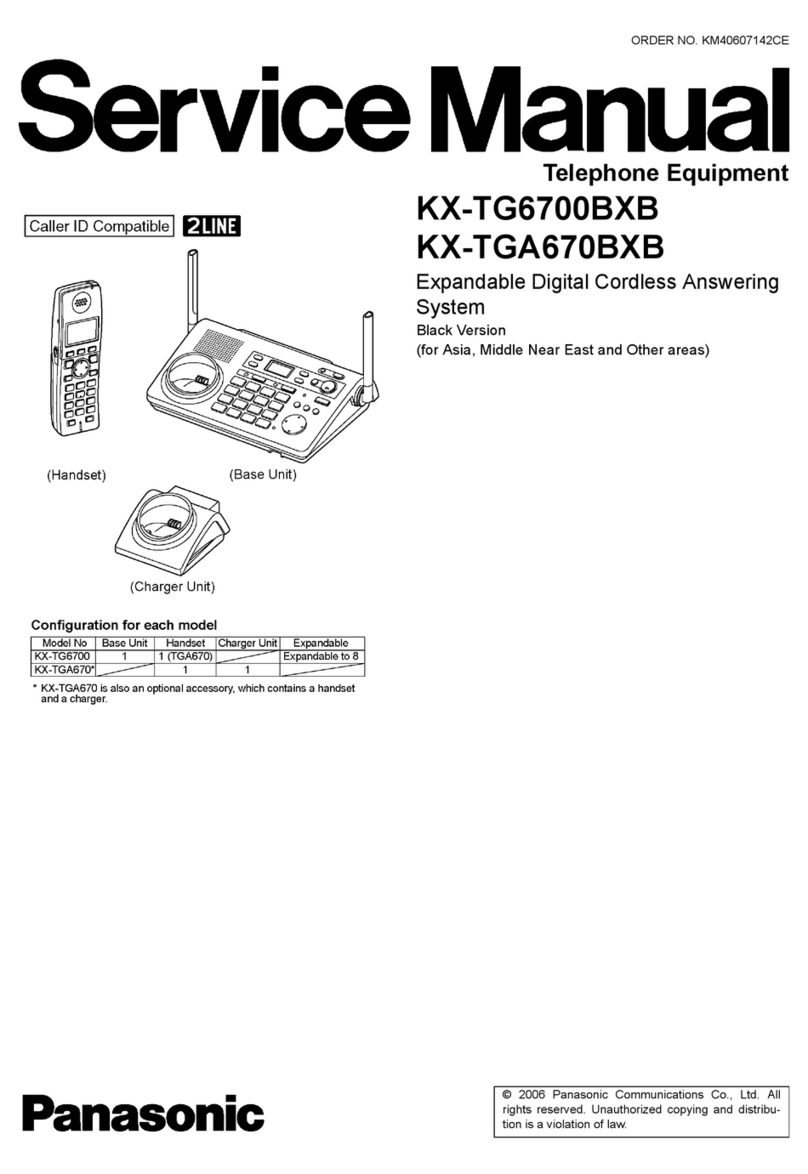
Panasonic
Panasonic KX-TG6700BXB Service manual
